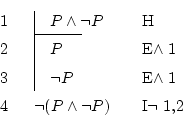Next: 5.11 This one seems Up: 5 Explained exercises Previous: 5.9 Left side empty. Contents
Another simple one,
![]() . It's done this way:
. It's done this way:

We all know that two contrary things can't happen at the same time, but, how can this be proved? We must use the reduction to the absurd:
Suppose that it does happen ![]() . Then happen both
. Then happen both ![]() and
and ![]() , both at the same time, which is a contradiction. So,
the supposition we just done can't be true: it's false. This way we
can prove
, both at the same time, which is a contradiction. So,
the supposition we just done can't be true: it's false. This way we
can prove
![]() .
.
When you see something so clear and obvious as
![]() ,
then its contrary will be clearly false and absurd. So, it
won't be too difficult to see that it doesn't hold and that it contradicts
itself. Once done, we can assure that the original formula is true
since its contrary is false.
,
then its contrary will be clearly false and absurd. So, it
won't be too difficult to see that it doesn't hold and that it contradicts
itself. Once done, we can assure that the original formula is true
since its contrary is false.